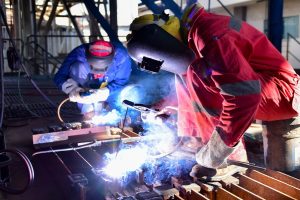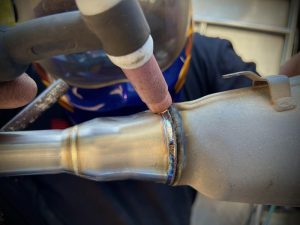
Common Defects in Welding and How to Avoid Them
Release time:2025-08-22 Click:22Welding is an essential process used to join materials, usually metals, by causing coalescence. It plays a crucial role in industries ranging from construction and automotive to aerospace and energy. While welding is highly effective, it’s not without challenges. Common defects in welding can affect the quality, integrity, and durability of the welded joints. In this article, we will discuss the most common defects encountered during the welding process, the causes behind them, and how to avoid them to ensure high-quality welds.
Welding defects refer to imperfections that occur during the welding process, which can compromise the strength, performance, or aesthetics of a welded structure. These defects can occur at various stages of welding and may be caused by factors such as improper settings, environmental conditions, material quality, or operator error. While some defects are minor and can be corrected, others can be detrimental to the integrity of the welded component.

Porosity is one of the most common defects in welding and is characterized by small holes or cavities on the surface or within the weld bead. These holes are created by trapped gas bubbles that form during the welding process.
Causes of Porosity:
Moisture in the filler material or base metal.
Inadequate shielding gas or improper gas flow.
Contaminants, such as oil, rust, or dirt, on the material surfaces.
Low welding temperatures or improper welding techniques.
How to Avoid Porosity:
Ensure that the base material and filler rod are clean and free of moisture, rust, and oils.
Use high-quality shielding gases and maintain the proper gas flow rate during the welding process.
Maintain proper arc length and ensure the welding technique is stable.
Use preheating for materials that are susceptible to porosity.
Cracking in a weld can occur during the solidification process or due to stress after the welding process is completed. Cracks may appear in the weld metal, heat-affected zone (HAZ), or along the interface between the weld and the base metal.
Causes of Weld Cracking:
Rapid cooling or improper cooling rates.
High levels of stress or insufficient preheating.
Incompatible welding materials or filler rods.
Residual stresses from the welding process.
Lack of joint fit-up or poor joint design.
How to Avoid Weld Cracking:
Use controlled cooling methods to prevent rapid cooling.
Preheat the base material and filler metal to reduce thermal shock.
Choose compatible materials for welding and ensure proper filler rod selection.
Use proper joint design and fit-up to reduce stress concentration.
Control the heat input by adjusting welding parameters such as current, voltage, and speed.
Undercutting is a type of defect where the base metal is eroded along the edges of the weld bead, leaving a groove or notch. This defect can lead to a significant reduction in the strength of the weld and is often visible on the surface.
Causes of Undercutting:
Excessive heat input, which causes the base metal to melt away.
Incorrect welding parameters such as high welding speed or low filler material.
Poor torch angle or improper technique.
How to Avoid Undercutting:
Maintain correct heat input to avoid excessive melting of the base metal.
Adjust welding parameters such as speed, current, and voltage to prevent overheating.
Ensure that the torch angle is appropriate and maintain a steady hand during welding.
Use proper filler material to fill the joint adequately and minimize undercutting.
Incomplete fusion occurs when the weld metal fails to fuse properly with the base metal or adjacent weld layers. This defect leads to weak points in the joint that could cause failure under stress.
Causes of Incomplete Fusion:
Insufficient heat input.
Incorrect welding speed or angle.
Inadequate filler material.
Contaminated surfaces or improper joint preparation.
How to Avoid Incomplete Fusion:
Adjust welding parameters to ensure sufficient heat input for proper fusion.
Use the correct welding technique and angle to ensure that the filler material fuses properly with the base metal.
Clean the base material thoroughly to remove contaminants such as oils, rust, and dirt.
Ensure proper joint preparation with good fit-up and clean surfaces.
Overlap is a defect that occurs when the weld metal flows over the base metal without fusing properly. This results in a surface defect where the weld metal does not penetrate sufficiently into the base material, leading to weak bonding.
Causes of Overlap:
Excessive heat input.
Incorrect torch angle or technique.
Inadequate filler material or poor joint fit-up.
How to Avoid Overlap:
Control heat input to avoid overheating the base metal and causing the filler material to flow improperly.
Maintain the correct welding technique and torch angle to ensure proper fusion.
Ensure proper joint fit-up to reduce the chances of overlap and ensure adequate penetration.
Spatter refers to the scattering of molten metal droplets that are ejected from the weld pool and land on the surrounding surface. While it does not necessarily affect the strength of the weld, it can impact the appearance and require additional cleaning.
Causes of Spatter:
High welding currents or excessive heat input.
Incorrect arc length or unstable arc.
Inappropriate shielding gas or insufficient gas coverage.
How to Avoid Spatter:
Adjust welding parameters to maintain a stable arc and reduce excessive heat.
Ensure proper arc length and maintain consistent travel speed.
Use the appropriate shielding gas and check gas flow rate to ensure adequate coverage.
Distortion is the warping or bending of the base metal due to uneven heating and cooling during the welding process. Distortion can affect the alignment and dimensional accuracy of the welded structure.
Causes of Distortion:
Uneven heating and cooling due to improper welding technique.
Rapid cooling rates.
Large sections of material being welded simultaneously.
How to Avoid Distortion:
Control the heat input and minimize the number of passes required for welding.
Use proper welding techniques such as back-step or staggered welding to balance heating.
Preheat the material to reduce thermal shock.
Use fixturing or clamping to keep the base metal in place during the welding process.
Lack of penetration occurs when the weld metal does not fully penetrate the base metal, leaving a gap between the weld and the base material. This defect compromises the strength and durability of the weld.
Causes of Lack of Penetration:
Insufficient heat input.
Incorrect torch angle or movement.
Inadequate filler material.
Poor joint preparation.
How to Avoid Lack of Penetration:
Ensure proper heat input and welding parameters for deep penetration.
Maintain proper torch angle and ensure consistent motion during welding.
Clean the base material before welding and ensure the joint is prepared adequately.

Welding defects are common in many welding projects, but with proper care and attention, they can be avoided. By understanding the causes of these defects and implementing effective strategies to mitigate them, you can significantly improve the quality, durability, and integrity of your welds. Proper material preparation, welding parameters, and techniques play a crucial role in minimizing defects and ensuring that welded joints meet the required standards for strength and safety.
Welding defects are often caused by improper technique, incorrect settings (such as heat input, speed, and voltage), contaminated materials, or poor joint preparation.
Yes, many welding defects such as porosity, undercutting, or lack of fusion can be repaired by re-welding or reworking the affected area. However, some defects like cracks may require more extensive repair.
To prevent porosity, ensure that the materials are clean and dry, use the correct shielding gas, maintain proper gas flow, and avoid contaminants on the material surfaces.
Shielding gas protects the weld pool from contamination by atmospheric gases such as oxygen, nitrogen, and water vapor, which can cause defects like porosity and oxidation.
Heat input can be controlled by adjusting the welding parameters such as current, voltage, and travel speed to ensure that the weld pool is stable without overheating the material.